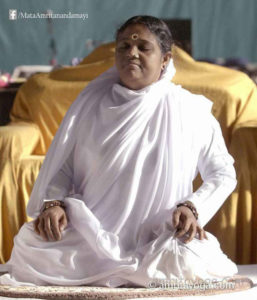 The Art of Breathing
The Art of Breathing
Since I began teaching yoga in 2004, I have found that the most common question is: How should I breathe?
My reply is always: Stay relaxed. Even if you are not aware of it, you are still breathing.
Try to observe this natural process to find the hidden secrets of the breath. Most people do not know how to breathe. Strange fact, isn’t it? But it’s a fact.
Breathing naturally isn’t the same thing as taking deep and meaningful breaths. I don’t mean ‘meaningful’ in a spiritual sense, either. I’m talking about breathing properly in a physical sense. Yoga can teach you everything about the art of breathing.
The Problem With Forgetting How to Breathe
We could talk about how we are so closed off as a society that we simply do not breathe. Without breath awareness, it’s easy to become stressed out. We don’t even know how to function in the world without stress.
As Amma says:
“We should be focusing on a stress-free life, but we all take on stress, freely.”
Ways That Yoga Helps You Breathe
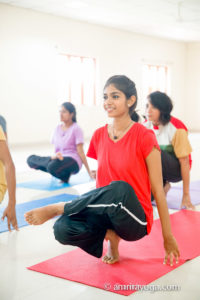 As you advance in your daily yoga practice, you will find that breath is an important component of basic yoga asanas. You can teach yourself to breathe from your diaphragm, since that is where your breath should really come from. If you watch an advanced practitioner, you will see the diaphragm move in and out regularly – almost an exaggerated movement. This is the type of breathing that you want to feel and experience.
As you advance in your daily yoga practice, you will find that breath is an important component of basic yoga asanas. You can teach yourself to breathe from your diaphragm, since that is where your breath should really come from. If you watch an advanced practitioner, you will see the diaphragm move in and out regularly – almost an exaggerated movement. This is the type of breathing that you want to feel and experience.
Try out these breathing tips:
- Breathe from your diaphragm
- Breathe in and out deeply and smoothly
- Let your breath flow regularly
When you are in savasana, feel your breath. You can even breathe deeply from your diaphragm when you are sitting in a car, at a desk, or anywhere else. Then, as you move through your basic yogasanas every day, you can learn to concentrate on your breath. Meditation teaches us to breathe more deeply, too.
How to Breathe
Yoga has a very scientific approach to breathing. Most people use only one third of their lung capacity. Yoga teaches abdominal breathing, which allows us to use more of our lung capacity. You can breathe more deeply, relax, and observe the movement of the abdomen. Practicing asanas with deep breathing expands the chest cavity, the intercostal muscles, and the lungs to develop the respiratory system and foster relaxation.
As we grow older, the intercostal muscles stiffen, the breastbone drops, and the chest compresses. Breathing more deeply allows us to lift the breastbone into place. The diaphragm, thoracic, intercostal muscles, and pectorals will then work correctly.
The Yoga of Everyday Breathing
With a relatively small amount of effort in breath work, you can yield powerful results. Considering this, there is surprisingly little teaching offered on this subject compared to all the other health practices done around the world. The fact that the respiratory system is the only system in our bodies that is both voluntary and involuntary speaks of its natural importance as a tool for betterment – something known and practiced for a long time in India.
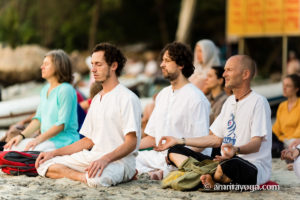 In yoga, we of course have the science of pranayama, and many of us are familiar with practices such as nadi sodhana (alternate nostril breathing) and kumbhaka (breath retention). However, there is a simpler type of breath work that can dramatically increase our wellbeing not only through our practice but in our daily lives as well – every single moment, even when sleeping. The steps for this type of transformative breathing are simple but, like anything that is new, they do require practice.
In yoga, we of course have the science of pranayama, and many of us are familiar with practices such as nadi sodhana (alternate nostril breathing) and kumbhaka (breath retention). However, there is a simpler type of breath work that can dramatically increase our wellbeing not only through our practice but in our daily lives as well – every single moment, even when sleeping. The steps for this type of transformative breathing are simple but, like anything that is new, they do require practice.
The key is to keep things natural. In general, when nature breathes its rhythms of life, there is no tension. This is the way it should be for us as well. Tension in the musculoskeletal system is a reflection of what is happening in the nervous system. If there is tension in our bodies, the sympathetic nerves have taken over and activated a response that is stress-inducing and thus life-force reducing. When breathing without tension, the body activates the parasympathetic nerves, which causes a relaxation effect.
Observing the Breath
Let us return to the question about how to practice tension-free and transformative breathing in both yoga practices and our daily lives.
The answer is simple. It starts with observation – so let’s try it now:
Put your awareness into your breathing and witness how your breath is doing. Notice if you are breathing through your nose or mouth. Is your breath short or long, even or irregular? Is there any tension at any stage of your breath cycle? Just take a moment and observe these things. Allow your focus to relax into your body, and feel what is going on. Do not try to change anything,
It is important to first learn how to recognize what is happening before trying to change anything. The more you practice observing yourself, the easier it becomes to avoid unwanted habits. In daily life, when emotions and the whirlwind of routines may take over, it is vital to observe your breath in different situations. When you are driving, working towards a timeline, on a holiday, cooking a fantastic meal or talking to someone, try to tune into your breathing as often as you can and notice the differences in the quality of your breath.
If you do encounter tension, ease back to about two thirds of your current effort. This range will allow you to stay within the comfort zone of the parasympathetic nervous response so you can stay more relaxed in life situations and your practice. Naturally, it is easier said than done, especially when you are late for that super important appointment or get stuck in traffic when you haven’t had breakfast yet.
Here are some ways to practice breathing:
1. Breath Awareness
Once you get used to feeling your breath in yoga asana practice, you can slowly let this breath awareness seep into other times of the day. You can create a habit of tuning into your breath. Noticing where your breath is prominent and how it feels in different asanas trains you in this ability to nurture this most precious life support system.
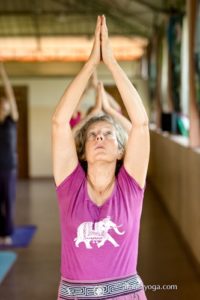
2. Breathe through your Nose
The second thing to do is make sure you are breathing through your nose. This is a more natural way of breathing than through the mouth. It is the efficient way that the sinuses regulate air temperature and filter toxins. We are built to breathe through our nostrils, not our mouth.
3. Abdominal Breathing
When you have started a habit of observation and breathing through your nostrils, you can begin focusing on breathing into your belly. Deep abdominal breathing not only activates the relaxation response, but it also increases your oxygen intake and transfer into your blood, making your blood more alkaline. Cultivating a habit of deep abdominal breathing improves mental clarity and the ability to do physical activity.
Often, in stressful situations, our breath tends to rise to our chests, which is an anxiety-inducing response. Breathing into the belly helps counter such emotions.
4. Focusing on the Specific Area in the Body
The key again is to recognize when it happens. Once you have become better at observing your breath, you learn to recognize when tension is just about to occur, and you can deal with it before it kicks in fully. This is also a great practice while doing yoga. Oftentimes the breathing is specified to a certain area in the body, depending on the asana, and you can focus on that area easily. For instance, in child’s pose we can really feel the breath in the lower and upper back, whereas in any side stretch we can feel the breath emphasized in the midriffs and the ribs.
Use your diaphragm consciously. This means that when you inhale, you should be aware of pushing the diaphragm down throughout the whole torso. The front, the sides and the back of the diaphragm should be equally active and expand your belly and sides evenly. When you exhale, actively pull up the diaphragm on all sides – don’t just release and let it collapse.
5. Rhythmic Breathing
The exhalation is a crucial part of the breath cycle as it is when the oxygen is actually transferred into your blood cells.
Physiologically, it is easier to have a longer in-breath than out-breath. This is because the veins that carry your blood cells back to your heart from your extremities during the exhalation are thinner than the arteries that carry your blood cells away from your heart during the inhalation. To keep your body working at maximum efficiency, your exhalation needs to be as long as your inhalation. This is called the rhythmic breathing. Traditional yoga texts confirm this.

These are the first steps you can practice right away to improve your yoga practice and wellbeing. Very practical, yet immensely useful, they can help you get started in using your breath more efficiently and consciously. Through the habit of observation, you can learn to apply the above methods when you find yourself needing to trigger a relaxation response. This is very useful in daily life.
The Science of Prana
The next stage of this practice is learning to breathe into your organs and soft tissues in order to recognize imbalances within your body and further improve your health. This is a key to deepening your pranayama practice, as it trains you to become more sensitive to the qualities of prana. Eventually, you learn how to distinguish prana from the air you breathe and you start to feel the flow of prana within the channels of your body.
Amrita Yoga® has a workshop called A.R.I.S.E. which teaches students to notice the movement of the five kinds of prana during asana practice.
These are called the Pancha pranas, the five vital airs.
- Prana – is the vital energy that governs respiration and speech.
- Apana – is below the navel and controls expulsion of waste from the body.
- Samana – is between the heart and the navel. It activates the circulatory and digestive energies.
- Udana – this activates the limbs and the area above the neck, including the sense receptors, the eyes, the nose and the ears.
- Vyana – is the vital energy that pervades the whole body and directs all the other pranas.
A student testimonial from the ARISE workshop
The presentation of this knowledge of the prana vayus is essential. It is extremely important to be aware of their presence, function and role in bringing the body, mind and consciousness into a healthy balance. It is exactly this open and enlightened space that is absolutely essential. It is the basic literacy that most people, including yoga practitioners, do not possess. Thank you so much for this amazing awareness! It is the beginning of my use of these tools in my yoga practice and daily life.—Vidya, Chicago, USA.
This practice requires the teaching from a true master, a Self-realized being. The more training you receive, the deeper you go within and the more subtlety is involved. Amma does recommend practicing simple pranayama. Amma teaches us very simple breath awareness and visualizations as part of the meditation practices.
Even with the simple techniques shared here you can improve the quality of your breathing and watch as your old habits automatically change into better ones. This way, you can be doing a breath practice at all times of the day with less and less effort. Your breath naturally becomes effortless – longer and smoother – and you will also find it easier to deal with everyday matters.
Simple ways and powerful results are all just a breath away.





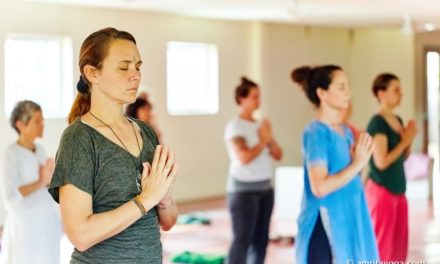
GreatExcellentGoodVery good postarticle. I amI’mI will be facingdealing withgoing throughexperiencing a few of thesesome of thesemany of these issues as well..
This is a topic that isthat’swhich is close tonear to my heart… CheersMany thanksBest wishesTake careThank you! WhereExactly where are your contact details though?
When I originallyinitially commented I clicked the “Notify me when new comments are added” checkbox and now each time a comment is added I get fourthreeseveral emailse-mails with the same comment. Is there any way you can remove mepeople from that service? ThanksBless youThanks a lotAppreciate itCheersThank youMany thanks!